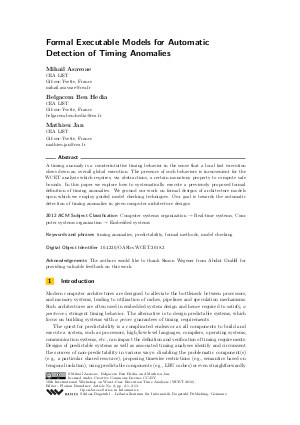Formal Executable Models for Automatic Detection of Timing Anomalies
Authors Mihail Asavoae, Belgacem Ben Hedia, Mathieu Jan
-
Part of:
Volume:
18th International Workshop on Worst-Case Execution Time Analysis (WCET 2018)
Part of: Series: Open Access Series in Informatics (OASIcs)
Part of: Conference: Workshop on Worst-Case Execution Time Analysis (WCET) - License:
 Creative Commons Attribution 3.0 Unported license
Creative Commons Attribution 3.0 Unported license
- Publication Date: 2018-09-24
File

PDF
OASIcs.WCET.2018.2.pdf
- Filesize: 387 kB
- 13 pages
Document Identifiers
Subject Classification
ACM Subject Classification
- Computer systems organization → Real-time systems
- Computer systems organization → Embedded systems
Keywords
- timing anomalies
- predictability
- formal methods
- model checking
Metrics
- Access Statistics
-
Total Accesses (updated on a weekly basis)
0PDF Downloads0Metadata Views
Abstract
A timing anomaly is a counterintuitive timing behavior in the sense that a local fast execution slows down an overall global execution. The presence of such behaviors is inconvenient for the WCET analysis which requires, via abstractions, a certain monotony property to compute safe bounds. In this paper we explore how to systematically execute a previously proposed formal definition of timing anomalies. We ground our work on formal designs of architecture models upon which we employ guided model checking techniques. Our goal is towards the automatic detection of timing anomalies in given computer architecture designs.
Cite As Get BibTex
Mihail Asavoae, Belgacem Ben Hedia, and Mathieu Jan. Formal Executable Models for Automatic Detection of Timing Anomalies. In 18th International Workshop on Worst-Case Execution Time Analysis (WCET 2018). Open Access Series in Informatics (OASIcs), Volume 63, pp. 2:1-2:13, Schloss Dagstuhl – Leibniz-Zentrum für Informatik (2018)
https://doi.org/10.4230/OASIcs.WCET.2018.2
BibTex
@InProceedings{asavoae_et_al:OASIcs.WCET.2018.2,
author = {Asavoae, Mihail and Ben Hedia, Belgacem and Jan, Mathieu},
title = {{Formal Executable Models for Automatic Detection of Timing Anomalies}},
booktitle = {18th International Workshop on Worst-Case Execution Time Analysis (WCET 2018)},
pages = {2:1--2:13},
series = {Open Access Series in Informatics (OASIcs)},
ISBN = {978-3-95977-073-6},
ISSN = {2190-6807},
year = {2018},
volume = {63},
editor = {Brandner, Florian},
publisher = {Schloss Dagstuhl -- Leibniz-Zentrum f{\"u}r Informatik},
address = {Dagstuhl, Germany},
URL = {https://drops.dagstuhl.de/entities/document/10.4230/OASIcs.WCET.2018.2},
URN = {urn:nbn:de:0030-drops-97481},
doi = {10.4230/OASIcs.WCET.2018.2},
annote = {Keywords: timing anomalies, predictability, formal methods, model checking}
}
Author Details
References
-
J. Eisinger, I. Polian, B. Becker, A. Metzner, S. Thesing, and R. Wilhelm. Automatic identification of timing anomalies for cycle-accurate worst-case execution time analysis. In DDECS, pages 15-20, 2006.

-
G. Gebhard. Timing anomalies reloaded. In WCET, pages 1-10, 2010.

-
G. Gebhard. Static timing analysis tool validation in the presence of timing anomalies. PhD thesis, Saarland University, 2013.

-
S. Hahn, M. Jacobs, and J. Reineke. Enabling compositionality for multicore timing analysis. In RTNS, pages 299-308, 2016.

-
S. Hahn, J. Reineke, and R. Wilhelm. Towards compositionality in execution time analysis: Definition and challenges. SIGBED Rev., 12(1):28-36, 2015.

-
J. Henry, M. Asavoae, D. Monniaux, and C. Maiza. How to compute worst-case execution time by optimization modulo theory and a clever encoding of program semantics. In LCTES, pages 43-52, 2014.

-
R. Kirner, A. Kadlec, and P. Puschner. Precise worst-case execution time analysis for processors with timing anomalies. In ECRTS, pages 119-128, 2009.

-
L. Lamport. Specifying Systems: The TLA+ Language and Tools for Hardware and Software Engineers. Addison-Wesley Longman Publishing Co., Inc., 2002.

-
M. Langenbach, S. Thesing, and R. Heckmann. Pipeline modeling for timing analysis. In SAS, pages 294-309, 2002.

-
J. Larus. Whole program paths. In PLDI, pages 259-269, 1999.

-
T. Lundqvist and P. Stenström. Timing anomalies in dynamically scheduled microprocessors. In RTSS, pages 12-21, 1999.

-
S. Merz. On the logic of TLA+. Comp. and Artificial Intelligence, 22(3-4):351-379, 2003.

-
J. Reineke and R. Sen. Sound and efficient WCET analysis in the presence of timing anomalies. In WCET, 2009.

-
J. Reineke, B. Wachter, S. Thesing, R. Wilhelm, I. Polian, J. Eisinger, and B. Becker. A definition and classification of timing anomalies. In WCET, 2006.

-
L. Thiele and R. Wilhelm. Design for timing predictability. Real-Time Systems, 28(2-3):157-177, 2004.

-
I. Wenzel, R. Kirner, P. Puschner, and B. Rieder. Principles of timing anomalies in superscalar processors. In QSIC, pages 295-306, 2005.

-
R. Wilhelm, D. Grund, J. Reineke, M. Schlickling, M. Pister, and C. Ferdinand. Memory hierarchies, pipelines, and buses for future architectures in time-critical embedded systems. IEEE Trans. on CAD of Integrated Circuits and Systems, 28(7):966-978, 2009.

-
Y. Yu, P. Manolios, and L. Lamport. Model checking TLA+ specifications. In CHARME, pages 54-66, 1999.

